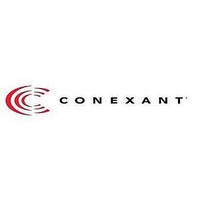RS8953 Conexant Systems, Inc., RS8953 Datasheet - Page 39

RS8953
Manufacturer Part Number
RS8953
Description
High-bit-rate Digital Subscriber Line (hdsl) Channel unit
Manufacturer
Conexant Systems, Inc.
Datasheet
1.RS8953.pdf
(173 pages)
Available stocks
Company
Part Number
Manufacturer
Quantity
Price
Part Number:
RS8953BEPF
Manufacturer:
CONEXANT
Quantity:
20 000
Company:
Part Number:
RS8953BEPJ28953-17
Manufacturer:
CONEXANT
Quantity:
1 238
- Current page: 39 of 173
- Download datasheet (953Kb)
RS8953B/8953SPB
HDSL Channel Unit
N8953BDSB
3.2.1.3 PRBS Generator
3.2.1.2 Transmit
Routing Table
application is asynchronously mapped, and the placement of timeslots, frames
and multiframes is not aligned to HDSL payload bytes, blocks, or frames.
Asynchronously mapped applications require the entire PCM serial data stream
be transported; the transmitter cannot discern timeslot or frame boundaries.
thus enabling transport to multiple remote sites and allowing PCM to operate at
rates which exceed available HDSL payload. However, synchronously mapped
channels are subject to changes in transmit frame alignment, resulting from
changes of the TMSYNC reference. ETSI defines synchronous and asynchronous
mapping depending on the type of E1 transport. Bellcore requires synchronous
T1 frame mapping for F-bits to align with Z-bit positions. (Refer to frame formats
and mapping arrangements illustrated in
Tables 3-2
Timeslot and F-bit data are shifted from PCM inputs into the TFIFO according to
the programmed transmit Routing Table [ROUTE_TBL; addr 0xED]
assignments. The routing table contains an entry for each PCM timeslot and the
system selects 1, 2, 3, or none of the HDSL transmit channels as the timeslot’s
destination. The system also selects which source (TSER, INSDAT, PRBS
generator or previous timeslot) supplies data for the destination. In this manner,
the routing table allows a single timeslot to be routed to more than one HDSL
channel, and a single timeslot to supply a repeated value to destination channels.
If INSDAT supplies source data, then the INSERT output marks PCM sampling
times corresponding to that timeslot (refer to
timing). Note that INSDAT is sampled through the previous buffer and is routed
in the subsequent timeslot table entry.
Incoming PCM transmit timeslots can be replaced by a test pattern on a
per-timeslot basis, or the entire framed or unframed PCM transmit channel can be
replaced by a test pattern (see PRBS_MODE in CMD_3; addr 0xE7 and
BER_SEL in CMD_6; addr 0xF3). When test pattern is enabled on a per-timeslot
basis according to the programmed transmit routing table assignments, the PRBS
generator is only clocked during enabled timeslots and may output a single test
pattern sequence over multiple discontinuous timeslots. The test pattern is
selected from one of four Pseudo-Random Bit Sequence (PRBS) patterns or a
programmable 8-bit fixed pattern [FILL_PATT; addr 0xEA]. PRBS pattern
selections are: 2
where QRSS equals 2
inverter in the data path. RS8953B does not provide a mechanism to
automatically insert logic errors in the test pattern, although the capability to
synchronize and measure test pattern errors is provided by the BER meter.
If the system does not apply PCM data aligned to MSYNC, then the
Synchronous mapping allows selective timeslot routing to HDSL channels,
and 3-3).
4
–1, 2
Conexant
20
15
–1 PRBS with 14-zero limit. The 2
–1, 2
23
–1 and Quasi-Random Signal Sequence (QRSS),
Figures 3-16
Figure 3-7
through 3-18, and
for INSERT signal
15
3.0 Circuit Descriptions
–1 test pattern has an
3.2 PCM Channel
3-7
Related parts for RS8953
Image
Part Number
Description
Manufacturer
Datasheet
Request
R

Part Number:
Description:
RS-232C / DIP16 / DMP16
Manufacturer:
JRC
Datasheet:

Part Number:
Description:
Bluetooth RF Transceiver
Manufacturer:
Conexant Systems, Inc.
Datasheet:

Part Number:
Description:
Bluetooth RF Transceiver
Manufacturer:
Conexant Systems, Inc.
Datasheet:

Part Number:
Description:
ATM transmitter/receiver with UTOPIA interface
Manufacturer:
Conexant Systems, Inc.
Datasheet:

Part Number:
Description:
Service SAR controller
Manufacturer:
Conexant Systems, Inc.
Datasheet:

Part Number:
Description:
CN8223EPFATM Transmitter/Receiver with UTOPIA Interface
Manufacturer:
Conexant Systems, Inc.
Datasheet:

Part Number:
Description:
Embedded modem family
Manufacturer:
Conexant Systems, Inc.
Datasheet:

Part Number:
Description:
Fully integrated T1/E1 framer and line interface
Manufacturer:
Conexant Systems, Inc.
Datasheet:

Part Number:
Description:
Flicker-free video encoder
Manufacturer:
Conexant Systems, Inc.
Datasheet:

Part Number:
Description:
Home Networking Physical Layer Device with Integrated Analog Front End Circuitry Data Sheet (Preliminary) CX82100-41Home Network Processor (HNP)
Manufacturer:
Conexant Systems, Inc.
Datasheet:

Part Number:
Description:
Manufacturer:
Conexant Systems, Inc.
Datasheet:

Part Number:
Description:
Manufacturer:
Conexant Systems, Inc.
Datasheet:

Part Number:
Description:
Manufacturer:
Conexant Systems, Inc.
Datasheet:

Part Number:
Description:
Flicker-free video encoder
Manufacturer:
Conexant Systems, Inc.
Datasheet:











